| |
Review Archive/November 2012
Updated November 19, 2012
Charleston, SC, Part II cont'd.
Old World Charm!
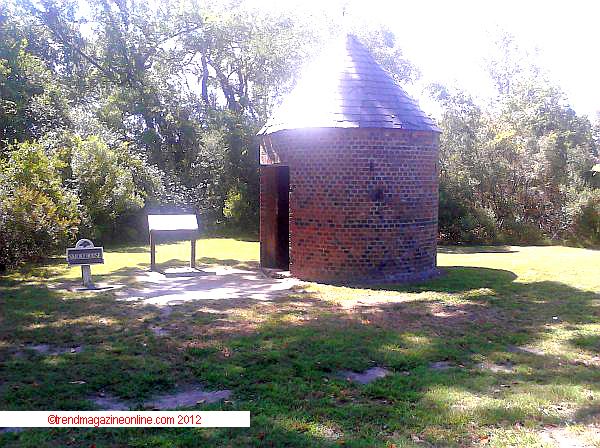 By Jay Whipple/Trend Magazine Online™ By Jay Whipple/Trend Magazine Online™
Next, it was on to what folks there describe as a must see presentation known as Exploring the Gullah Culture. It took place on the left and near the start of that fascinating row of live oak trees located at the entrance to the old plantation. On our way there we strolled down a path that leads us to a covered wooden deck over a creek that is used for weddings. They had these fans that were spritzing a fine mist of water outward to offset some of the mugginess inherent during hot and humid summer days in the low country. They were actually preparing for a wedding that very same early evening. How romantic, minus the prehistoric mosquitos of course.
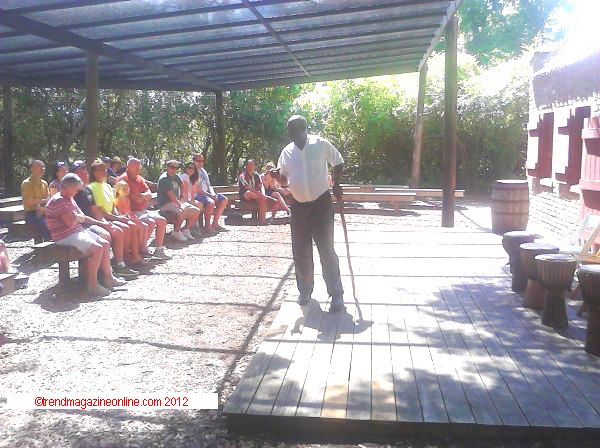 Right about this time, folks were seating themselves in a make-shift covered outdoor amphitheater, and we aptly joined them. The star of the Gullah presentation introduced himself as Brother Bob, a northern transplant with roots in Charleston, SC, who stated that he has studied low country history since the 1960’s. It did not take long for me to realize that this man was the real deal who spoke with authority and passion as he conveyed his knowledge of the culture also known as ”Geechy” or “Ceechy.” It was these folks, he said, that made the Charleston, SC, area the 2nd richest place in the United States behind New York. Their primary product was rice which came to be known as Carolina Gold. These very talented West Afrikaans, who were forced transplants, relied heavily on drumming as their main source of distant communications until it was outlawed by the Black Code in the mid 1860’s just after Slavery was abolished. Brother Bob also stated that Gullah folks are sometimes referred to as Goya; for rice cultivating drumming people. In addition, we learned that a Cuda is actually a turtle in the Gullah language and that there is no “str” sound in the Afrikaan language hence the word street is pronounced “scr”eet. Furthermore, there is no “th” sound so it has been replaced by the letter “d” therefore, the word “this” is pronounced “dis.” Right about this time, folks were seating themselves in a make-shift covered outdoor amphitheater, and we aptly joined them. The star of the Gullah presentation introduced himself as Brother Bob, a northern transplant with roots in Charleston, SC, who stated that he has studied low country history since the 1960’s. It did not take long for me to realize that this man was the real deal who spoke with authority and passion as he conveyed his knowledge of the culture also known as ”Geechy” or “Ceechy.” It was these folks, he said, that made the Charleston, SC, area the 2nd richest place in the United States behind New York. Their primary product was rice which came to be known as Carolina Gold. These very talented West Afrikaans, who were forced transplants, relied heavily on drumming as their main source of distant communications until it was outlawed by the Black Code in the mid 1860’s just after Slavery was abolished. Brother Bob also stated that Gullah folks are sometimes referred to as Goya; for rice cultivating drumming people. In addition, we learned that a Cuda is actually a turtle in the Gullah language and that there is no “str” sound in the Afrikaan language hence the word street is pronounced “scr”eet. Furthermore, there is no “th” sound so it has been replaced by the letter “d” therefore, the word “this” is pronounced “dis.”
We were also hipped to the fact that one of the favorite dishes/culinary 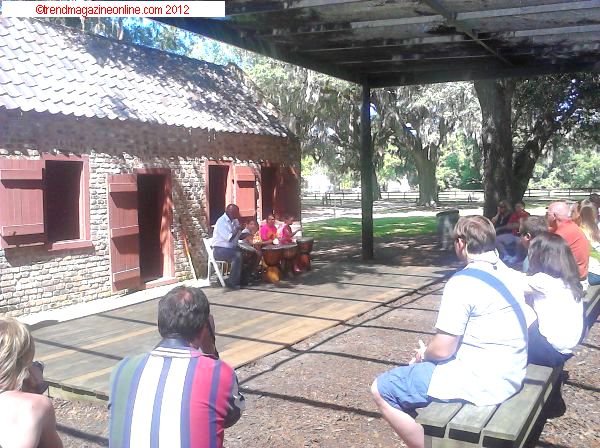 delights of the Gullah people are rice with lima beans. Brother Bob did not mention, however, their passion for moon pies and orange sodas as I learned from several Geechies that I served with in the United States Army. He also dispelled some myths concerning America’s perception of Voodoo versus the actual Afrikaans religious practice which is based on the belief that their ancestors, as opposed to God, are watching over them. He also conveyed that the Afrikaans Voodoo religion relies heavily on trees and other plant life instead of modern day medicine. If you really think about it, what did mankind do for ailments and sickness before the advent of pharmaceuticals? Our mostly white crowd were also introduced and treated to a demonstration of “call and response” using drumming with help from a few younger audience members. Brother Bob also taught us that some of the area Slaves fled to Florida to be free and in the process joined up with the Seminole Indians in 1739. They were later forced to move to Oklahoma during the travesty known today as the “Trail of Tears,” instigated by former President Andrew Jackson in 1838 and 1839. delights of the Gullah people are rice with lima beans. Brother Bob did not mention, however, their passion for moon pies and orange sodas as I learned from several Geechies that I served with in the United States Army. He also dispelled some myths concerning America’s perception of Voodoo versus the actual Afrikaans religious practice which is based on the belief that their ancestors, as opposed to God, are watching over them. He also conveyed that the Afrikaans Voodoo religion relies heavily on trees and other plant life instead of modern day medicine. If you really think about it, what did mankind do for ailments and sickness before the advent of pharmaceuticals? Our mostly white crowd were also introduced and treated to a demonstration of “call and response” using drumming with help from a few younger audience members. Brother Bob also taught us that some of the area Slaves fled to Florida to be free and in the process joined up with the Seminole Indians in 1739. They were later forced to move to Oklahoma during the travesty known today as the “Trail of Tears,” instigated by former President Andrew Jackson in 1838 and 1839.
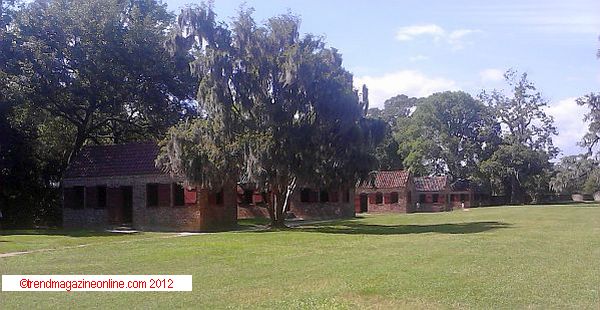 On our way to our last stop at the historic Boone Hall Plantation we were ingratiated by a row of former Slave huts that were converted into hubs of knowledge complete with a large flat screen television that conveyed visual and oral history dating back to the 1500's. In addition, each hut was adorned with pictures and additional information on each of the walls which provided a pleather of historic knowledge. I was really impressed with these exhibits because they recounted the stories just as they happened -- absent massive propaganda; just as we do on our Charlotte, North Carolina tours. I call it straight with no chaser! In these hubs of knowledge I got a chance to revisit the history of some of my favorite heroes and heroines like Gabriel Prosser, Denmark Vesey, Nat Turner, Harriet Tubman, Soujourner Truth, Frederick Douglass, and John Brown to name a few abolitionists. If it were not for these brave men and women, I am convinced that the barbaric institution of Slavery would still be in existence in the United States today. Unfortunately, there are those of us that have forgotten the ultimate price some of these folks paid to ensure freedom for all oppressed people. As such, I strongly suggest a stop in each one of these hubs of knowledge to refresh or educate yourself on their contributions to freedom.. On our way to our last stop at the historic Boone Hall Plantation we were ingratiated by a row of former Slave huts that were converted into hubs of knowledge complete with a large flat screen television that conveyed visual and oral history dating back to the 1500's. In addition, each hut was adorned with pictures and additional information on each of the walls which provided a pleather of historic knowledge. I was really impressed with these exhibits because they recounted the stories just as they happened -- absent massive propaganda; just as we do on our Charlotte, North Carolina tours. I call it straight with no chaser! In these hubs of knowledge I got a chance to revisit the history of some of my favorite heroes and heroines like Gabriel Prosser, Denmark Vesey, Nat Turner, Harriet Tubman, Soujourner Truth, Frederick Douglass, and John Brown to name a few abolitionists. If it were not for these brave men and women, I am convinced that the barbaric institution of Slavery would still be in existence in the United States today. Unfortunately, there are those of us that have forgotten the ultimate price some of these folks paid to ensure freedom for all oppressed people. As such, I strongly suggest a stop in each one of these hubs of knowledge to refresh or educate yourself on their contributions to freedom..
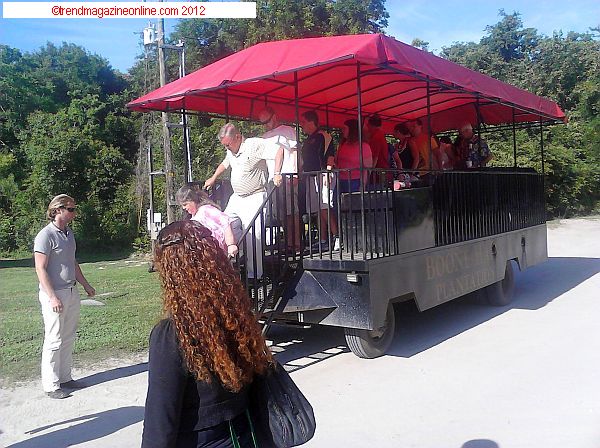 The last stop on our fun filled and very historically educational A Day In Charleston, SC, trip was the Coach Tour which was actually aboard an open-air trolley. I found out the hard way that the driver/docent does not play, when his trolley was full, he was ready to go – earlier than the schedule stated. As such, I had to rush back to my seat after making a water and refreshment run to our vehicle. Our driver/docent was named Trevor, a very peculiar “dude” who spoke with a laid back California surfer type accent. He seemed to really know his stuff as we began our journey/tour and he explained that cotton was still grown on the plantation but for educational purposes. I was surprised to learn that the plantation contained both fresh and salt water in proximity to each other. Wow, how is that possible I thought to myself? Early on our trek through the woods we made a brief stop on a make-shift bridge overlooking a pond that was home to wood ducks with eight babies, as Trevor pointed out. We then began to weave our way around tight corners along a narrow dirt road which was as First Lady Michelle Obama would say “really cool.” The last stop on our fun filled and very historically educational A Day In Charleston, SC, trip was the Coach Tour which was actually aboard an open-air trolley. I found out the hard way that the driver/docent does not play, when his trolley was full, he was ready to go – earlier than the schedule stated. As such, I had to rush back to my seat after making a water and refreshment run to our vehicle. Our driver/docent was named Trevor, a very peculiar “dude” who spoke with a laid back California surfer type accent. He seemed to really know his stuff as we began our journey/tour and he explained that cotton was still grown on the plantation but for educational purposes. I was surprised to learn that the plantation contained both fresh and salt water in proximity to each other. Wow, how is that possible I thought to myself? Early on our trek through the woods we made a brief stop on a make-shift bridge overlooking a pond that was home to wood ducks with eight babies, as Trevor pointed out. We then began to weave our way around tight corners along a narrow dirt road which was as First Lady Michelle Obama would say “really cool.”
Trevor explained to us that this land was once known as the Brickyard Plantation which developed around pecan trees in 1870. At one point in time they harvested 715 thousand trees, he said, and every November they host a reenactment of the Battle of Secessionville (1862) as he pointed out some of the props on the right. I was intrigued to learn that Spanish moss is not really Spanish nor is it “moss,” it is actually Brazilia according to our driver/docent. The entire plantation, he said, was supported by Indigo Blue, cotton, bricks, and pecans. Trevor then pointed out what they call “U-Picks” or self-service mini-farms where you can pick and then pay based on the weight of your crop. These mini-farms offer blueberries, peaches, muscadines, strawberries, and vegetables. We also drove by a honey bee farm on the left and I personally did not care to spend too much time in that area for obvious reasons. Our docent also pointed out some live oaks on the property that were 270 years old. Trevor also stated that those oaks could survive over 400 years. We then stopped by this little shack on the left which was featured in the hit series Queen (1993) starring the very pretty Halle Berry and written by the late Alex Haley (1921 - 1992). That series was a follow-up to his very popular mini-series known as Roots in the late 1970’s. On our way back to the beginning of our tour Trevor pointed out the gravesite of Mr. Boone on the right which again I thought was pretty creepy as explained earlier.
All in all this was a very fun-filled, adventurous, educational and worthwhile trek into and around the low country a.k.a. Charleston, SC. We ended our day trip by dining at one of their world-famous seafood restaurants in Downtown near the market. Needless to say, the food was delicious as expected.
Want to go? Join us for our next A Day In Charleston, SC, trip in June, or year round if you have a party of 10 or more.
<<<Back to Page 1
<<<Back to November 2012 Monthly Reviews
<<<Back to November 2012 Edition
<<<Back to Charleston Review Part I
To Reviews Archive>>>
Join our email list or "Like" Us on Facebook! to be notified of updates!
|
|

